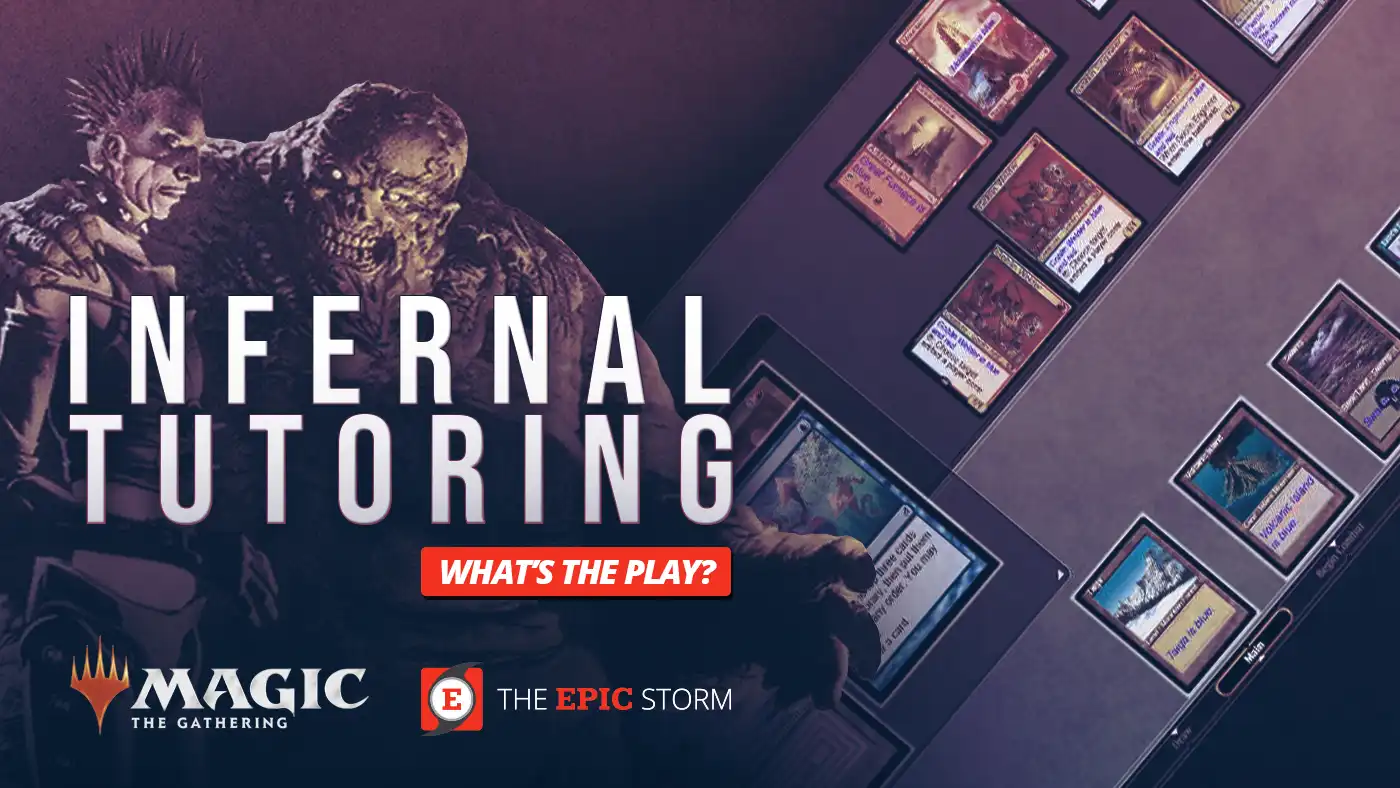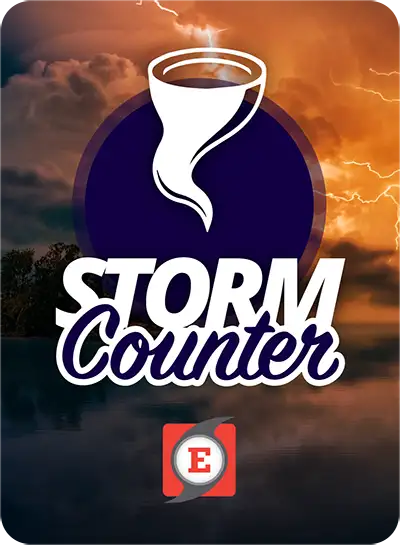Every so often, Legacy reaches beyond its devoted player base and draws the attention of other Magic players to this awesome format. Now is one of those times. Eternal Weekend is back! Wizards of the Coast announced the return of the beloved in-person events this year (mostly in-person, sorry Europe). Players often see success in this weekend of Legacy and Vintage events as the pinnacle achievement for their Magic career. Deck building, sideboard tweaking, and testing abound in the weeks leading up to the event as players adjust their expectations for what their event will look like. Much in the same way, The EPIC Storm is also undergoing a period of testing and changes.
With recent adjustments in the makeup of our sideboard and plans against meta decks, things have cascaded as space previously taken by [[Carpet of Flowers]] can be played around with. The first changes incorporated old favorites [[Crash]] and [[Grapeshot]] into the open slots. This was based on the understanding that lateral sideboard plans (upgrading good cards to great cards with the same effect) were not giving The EPIC Storm the match-up equity it needed. Further changes have been tested since then, with one standout decision being brought to the forefront.
As The EPIC Storm evolved to adopt a play style focused on permanents in play ([[Mishra's Bauble]] instead of [[Ponder]], [[Wishclaw Talisman]] over [[Infernal Tutor]], and the inclusion of [[Mox Opal]]), the Storm payoff of [[Galvanic Relay]] has slotted perfectly into the deck's construction. Since Modern Horizons 2, [[Galvanic Relay]] has seen consistent play in The EPIC Storm: slowly at first, then with a more concerted effort. This latest iteration, TES v13.4, is yet another step in that direction. The standout decision is cutting [[Tendrils of Agony]] from the mainboard to make room for a THIRD copy of [[Galvanic Relay]]. As The EPIC Storm explores the depths of play that [[Galvanic Relay]] offers, we have gone back to a main deck configuration that does not have a non-sideboard win condition. While this may seem absurd, the deck has succeeded in the past with this makeup. In fact, winning through a sideboard [[Tendrils of Agony]] has been the predominant build throughout the life of The EPIC Storm. The main-deck copy was added within the past few years, and it's time to go back to our roots.
Playing with v13.4 will stress players to refamiliarize themselves with the quirks of playing around cards like [[Surgical Extraction]]. The benefits of having [[Galvanic Relay]] number three in its place will come out after many repetitions. Cleaner early wins with consistent "Relay Turns" will stress the fair Blue decks of the format. Lowering the average mana value for [[Ad Nauseam]] by one pip will help somewhat if the effects will only be seen after many games. The biggest boon to cutting the [[Tendrils of Agony]] is you will never draw it when you don't want to. On the flip side, the lines involving [[Echo of Eons]] with a [[Wishclaw Talisman]] in play have been reduced somewhat. The low-resource outs of those draws have been reduced. So far that has yet to be an issue, but if you are playing this list, keep an eye out and let us know what you think.
Oh yeah, and we added two copies of [[Opposition Agent]] to the sideboard. No big deal.
This new addition speaks to the period of testing and changes that The EPIC Storm is in. A problem matchup that had the potential to be addressed was spotted. [[Doomsday]] is a combo deck that has a large amount of interaction as well. Instead of needing to use that interaction to protect their combo when we are matched up, they can use it as a major disruptive element instead. Playsets of [[Force of Will]] and [[Force of Negation]] are commonplace, as are other pieces of interaction like [[Duress]] and [[Flusterstorm]]. [[Opposition Agent]] offers a surgical tool against one of the top three decks in the meta right now. It also has the benefit of dodging [[Force of Negation]] and [[Duress]]. Landing an [[Opposition Agent]] can spell defeat, even without casting another spell! Alternatives were considered as well, perhaps you can see them in future versions of The EPIC Storm! For now, [[Opposition Agent]] has been performing well. Let's see if these changes can make a difference in the scenarios ahead of us.

Special Guest
Matt Sperling
Matt is a competitive Magic player with over 2 decades of pro-level experience and 4 top finishes under his belt.
Deck List
the epic Storm
Main Deck
- 4 [[Brainstorm]]
- 4 [[Veil of Summer]]
- 4 [[Mishra's Bauble]]
- 4 [[Wishclaw Talisman]]
- 4 [[Burning Wish]]
- 3 [[Galvanic Relay]]
- 1 [[Ad Nauseam]]
- 1 [[Echo of Eons]]
- 4 [[Rite of Flame]]
- 4 [[Dark Ritual]]
- 4 [[Lion's Eye Diamond]]
- 4 [[Lotus Petal]]
- 4 [[Mox Opal]]
- 3 [[Chrome Mox]]
- 4 [[Bloodstained Mire]]
- 1 [[Scalding Tarn]]
- 1 [[Misty Rainforest]]
- 1 [[Verdant Catacombs]]
- 1 [[Underground Sea]]
- 1 [[Volcanic Island]]
- 1 [[Bayou]]
- 1 [[Badlands]]
- 1 [[Taiga]]
Sideboard
- 2 [[Opposition Agent]]
- 2 [[Crash]]
- 2 [[Abrupt Decay]]
- 2 [[Chain of Vapor]]
- 1 [[Galvanic Relay]]
- 1 [[Thoughtseize]]
- 1 [[Empty the Warrens]]
- 1 [[Tendrils of Agony]]
- 1 [[Pulverize]]
- 1 [[Echo of Eons]]
- 1 [[Peer into the Abyss]]
SITUATION No. 1 — Ad Nauseam Tendrils
Ad Nauseam Tendrils is one of the prominent Storm decks in Legacy (generally ANT, Ruby, TEG, and TES), and is a classic choice for someone wanting to flex their combo muscles. In fact, it is one of the most common decks to have Top 8 finishes in Legacy Grand Prix competitions since the beginning of the format itself. With such a devoted following, the deck will never truly go away, despite recent modern printings harming the powerful [[Past in Flames]] strategy.
The differences that separate Ad Nauseam Tendrils from other Storm decks typically fall into either mana production or engine cards. Whereas The EPIC Storm and The EPIC Gamble utilize artifacts to make mana, Ad Nauseam Tendrils (along with Ruby Storm) rely more heavily on rituals to make mana. [[Cabal Ritual]] with Threshold is as mana-positive as [[Black Lotus]] itself! With this reliance on ritual effects, [[Past in Flames]] becomes more potent. Ad Nauseam Tendrils is a graveyard-based strategy that takes advantage of this zone more than other Storm variants. In fact, [[Past in Flames]] is a better engine card than [[Ad Nauseam]] in most cases, causing some slight confusion with naming conventions. With a lower amount of initial mana sources from artifacts, being able to loop rituals through the graveyard is more effective in low resource situations than hoping for [[Lotus Petal]] to be revealed with [[Ad Nauseam]].
Being more reliant on the graveyard does open Ad Nauseam Tendrils to more kinds of hate from opponents though. Cards like [[Leyline of the Void]], [[Surgical Extraction]], and [[Endurance]] can stop a [[Past in Flames]] line in its tracks. But there is an inherent resiliency to the card due to the Flashback ability, powering through counter magic by simply casting the card again on another turn. [[Force of Negation]] has severely limited the strength of that particular perk, but the recursive ability to try again at another point still has its benefits.
Against the pseudo-mirror, The EPIC Storm edges out the discard-based Storm deck for two reasons. First, we play an entire playset of [[Veil of Summer]]. Often touted as the reason Ad Nauseam Tendrils popularity has dropped off, there is typically no maindeck out to a resolved protection spell. Secondly, The EPIC Storm is a faster deck. Instead of focusing on cantripping and sculpting a position to strike as Ad Nauseam Tendrils does, The EPIC Storm can choose to leverage its speed if it needs to.
SIDEBOARDING:
+2 [[Opposition Agent]], +1 [[Thoughtseize]]; -3 [[Galvanic Relay]]
We find ourselves in a game one situation against our Ad Nauseam Tendrils opponent. The first turns told us a few things about our opponent. They discarded our [[Veil of Summer]] with [[Duress]] on their first turn and proceeded to cantrip twice without hitting their second land — burning a [[Lotus Petal]] to do so ([[Ponder]] shuffled). This can be taken as either a sign of weakness or that they are close to a win and need a specific piece to get there. In our second turn, we are resolving a [[Brainstorm]] and contemplating how to evaluate our opponent's position. The obvious plan with the cards available is to cast [[Echo of Eons]] with three mana floating and a land drop to make. Since that is not deterministic, we do risk passing the turn to our opponent who has the potential to win with a fresh seven cards. The alternative would be to plan ahead with this [[Brainstorm]] and set up a win later on. How do you evaluate our opponent's position here? Are they telegraphing weakness or strength? What should we do to resolve this [[Brainstorm]] and plan for the following turns, if there are any?
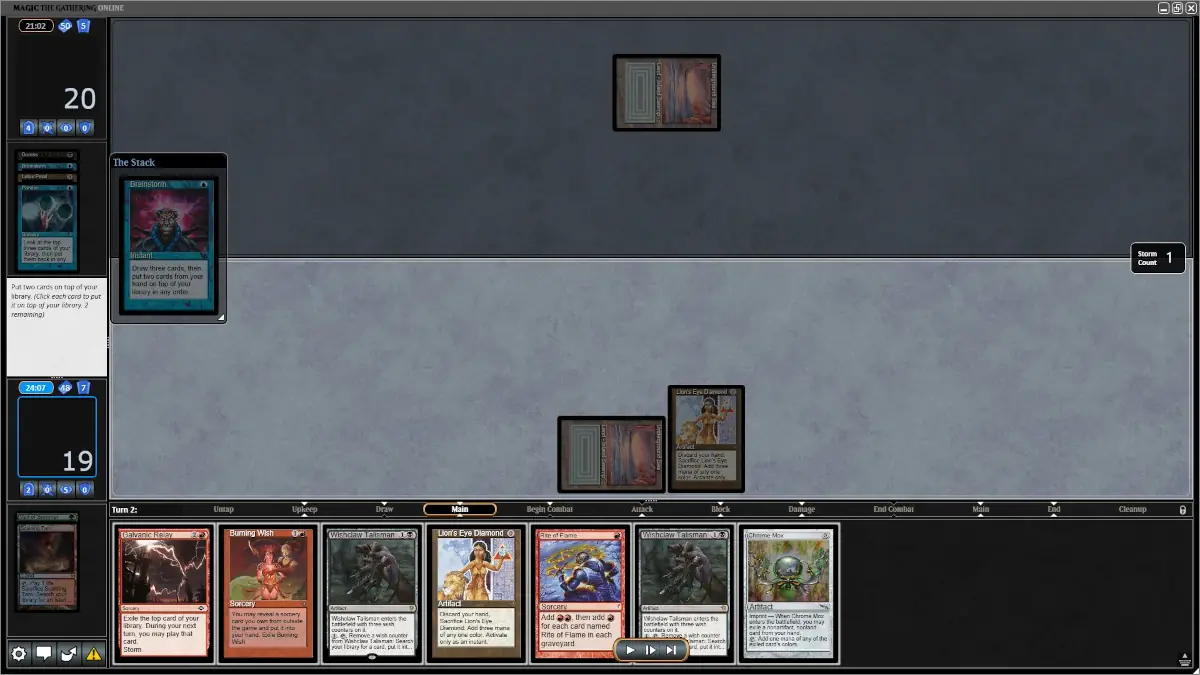
SITUATION No. 2 — Elves
Carcinization is a textbook example of convergent evolution: the process of Nature's attempts to evolve animals into crabs. Jundification is another example of the same effect: the process of Magic's attempts to evolve every deck into The Rock. Currently, Elves is undergoing that process in Legacy. What was once a creature-based combo deck build to abuse [[Glimpse of Nature]], started shifting philosophy with the printing of [[Elvish Reclaimer]] and has continued with [[Fiend Artisan]]. The deck has evolved into a strategy that is more akin to a toolbox than a combo machine. Of course, this isn't to say there isn't a combo. [[Natural Order]] into [[Craterhoof Behemoth]] is still as effective at ending the game as ever. The plan is more value-oriented than before. Much like Naya Depths, this new version of Elves actually has more tutors than most Storm decks! There is a more extreme version of this deck, with even fewer elf creatures and more reliance on [[Fiend Artisan]], but that has gone so far away from the elf strategy that it probably shouldn't be considered Elves anymore. Key cards in Elves include [[Green Sun's Zenith]], [[Natural Order]], [[Allosaurus Shepherd]], [[Elvish Reclaimer]], [[Fiend Artisan]], and [[Wirewood Symbiote]]. Powerfully resilient, Elves floods the battlefield with creatures that gain value the longer they are out and pays for everything with giant taps of [[Gaea's Cradle]] (in fact, Cradle Control is a tongue-in-cheek name for Elves that has been used ever since this philosophy shift). Their win conditions are [[Grist, the Hunger Tide]] and [[Craterhoof Behemoth]] — sometimes with alternative tutor targets out of the sideboard.
As it pertains to The EPIC Storm, Elves is primarily the biggest [[Collector Ouphe]] deck we have to contend with. Our strategy is typically faster than Elves, but this one card can shut down our game plan completely. We currently have no outs to this card in game one other than relying on rituals and [[Burning Wish]] to win. But since we have been shaving lands and cantrips in favor of more artifacts, this is not likely to happen. The goal is to win before the artifact hate hits the battlefield. [[Thoughtseize]] is a card frequently seen in Elves sideboards and [[Veil of Summer]] needs to stay in post-board in some numbers. It is unfortunate that the card has no function in game one (other than as a card to Imprint underneath [[Chrome Mox]]). One more note is that the previous list with [[Grapeshot]] did have outs to main-deck creatures like [[Collector Ouphe]] and [[Thalia, Guardian of Thraben]]. No sideboard is going to have the ability to beat everything. The 15 cards are in high demand and trying to have a plan for everything means that we are spread out too thinly to be impactful. The compromise here is to have a better plan against [[Doomsday]] and not have as many outs to resolved hate creatures.
SIDEBOARDING:
+2 [[Abrupt Decay]], +2 [[Chain of Vapor]]; -3 [[Galvanic Relay]], -1 [[Veil of Summer]]
Flipping [[Echo of Eons]] while resolving [[Ad Nauseam]] is never the greatest feeling. Turn-two combos though, that is a great feeling indeed. We are in a post-sideboard game against Elves and looking to find a path forward to lethal this turn. We have given our opponent a [[Wishclaw Talisman]] to get this far, meaning we would need to remove it from play or make a plan for [[Collector Ouphe]] if passing the turn is the play. We do not have a clean line to lethal with our current hand. Luckily for us, we don't have a main-deck [[Tendrils of Agony]] to reveal and kill us! The largest mana value we could reveal is two — not quite lethal. If we do reveal a two-drop, we are facing down lethal across the board. Dying to a [[Llanowar Elves]] is not a great way to go. With a floating in our mana pool, there has to be an avenue to victory. What cards do we need to flip to find a lethal line? If we need to pass the turn and try again, what protections do we need to prepare? What tools do we already have available to help make this decision easier?
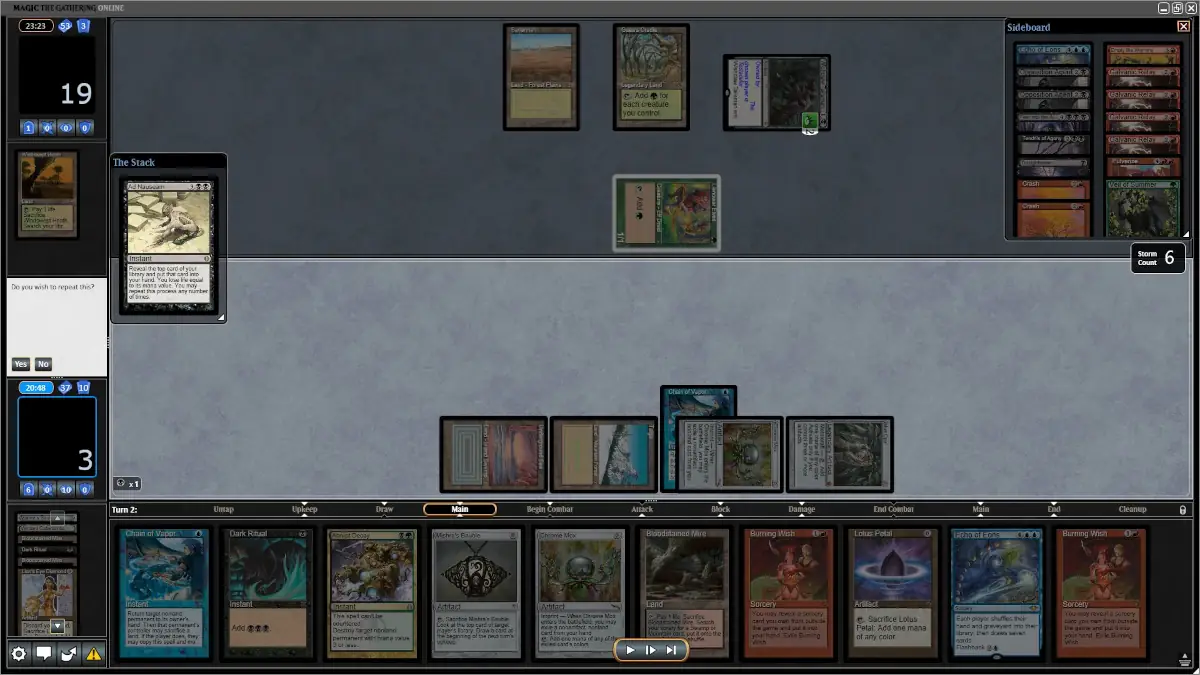
SITUATION No. 3 — Painter
Seeing a prolonged renaissance as of late, Painter decks are focused on abusing the interaction between [[Painter's Servant]] and [[Grindstone]] to mill an opponent out in one action. The strategy has received a large number of useful printings in recent sets. Cards like [[Goblin Engineer]], [[Urza's Saga]], [[Fury]], and [[Karn, the Great Creator]] have all bolstered the archetype into a strong contender in the Legacy scene. One inherent strength of Painter in the current Legacy meta is its ability to play up to six [[Pyroblast]] effects in the main deck. Generally good with a [[Painter's Servant]] naming Blue, the emphasis on Blue decks in the format has simply made the cards that much better. Pairing up against UR Delver or any of the various 4-Color Control decks can seem like a walk in the park. Recently, the deck won the Legacy Showcase Challenge in the hands of Callum Smith, one of the more outspoken supporters/lovers of the deck. The current versions of the deck are built upon the strength of [[Urza's Saga]], the artifact synergies of [[Goblin Welder]] and the power of [[Fable of the Mirror-Breaker]]. This new saga has rounded out non-Blue deck card selection and does everything you could want in a shell that does not leverage the power of the "Cantrip Cartel" of [[Brainstorm]] and [[Ponder]]. Painter is a very unique A + B combo deck that bolsters its main lines with backup plans of [[Construct Token]] beatdown and grindy artifact recursion.
The EPIC Storm can certainly win before Painter sets up their engines. If we cannot reach a combo turn quickly enough, the ability of Painter to interact in unintuitive ways abound. "Welding" a [[Lotus Petal]] and a [[Wishclaw Talisman]] can severely hamper our ability to deploy cards the turn before attempting a win. [[Pyroblast]]/[[Red Elemental Blast]] can also be cast using [[Simian Spirit Guide]] — don't assume a tapped-out opponent has no interaction! Older lists that play [[Karn, the Great Creator]] have thankfully diminished in popularity (thanks in part to the strength of [[Fable of the Mirror-Breaker]]), but there are many flavors of Painter. Red and White are paired together (this variant is generally called Strawberry Shortcake) to get cards like [[Ethersworn Canonist]] and [[Enlightened Tutor]]. Out of the sideboard things like [[Mindbreak Trap]], [[Leyline of the Void]], [[Thorn of Amethyst]], and [[Pithing Needle]] are cards that need to be on a player's radar. Let's see our situation where we need to play around a couple of these cards at the same time.
SIDEBOARDING:
+2 [[Chain of Vapor]], +2 [[Abrupt Decay]], +2 [[Crash]]; -3 [[Veil of Summer]], -3 [[Galvanic Relay]]
Our last situation picks up on our turn two. The first turn was spent deploying a significant portion of our hand with the intent of playing around [[Mindbreak Trap]]. Thanks to the MTGO client, we know that our opponent considered casting [[Mindbreak Trap]] when we put [[Wishclaw Talisman]] on the stack (they elected to let it resolve). Originally, the plan was to cast [[Dark Ritual]] and Flashback [[Echo of Eons]] after tutoring it with [[Wishclaw Talisman]], but two things happened that require us to change course. First, we cracked a [[Mishra's Bauble]] and our opponent's draw for their first turn was a [[Surgical Extraction]]. Without a main-deck win condition, our opponent would have the ability to remove [[Burning Wish]] from our deck and win the game. Second, we drew a [[Lion's Eye Diamond]] for our turn. With this new information, we need to formulate a new plan. One that also includes the knowledge that our opponent can "Weld" away our [[Wishclaw Talisman]] due to the [[Mishra's Bauble]] in the graveyard if we choose to pass the turn. How can we best play around both [[Surgical Extraction]] AND [[Mindbreak Trap]] this turn? If we cannot find a line to beat both, what set of actions gives us the best out to win in the following turns?
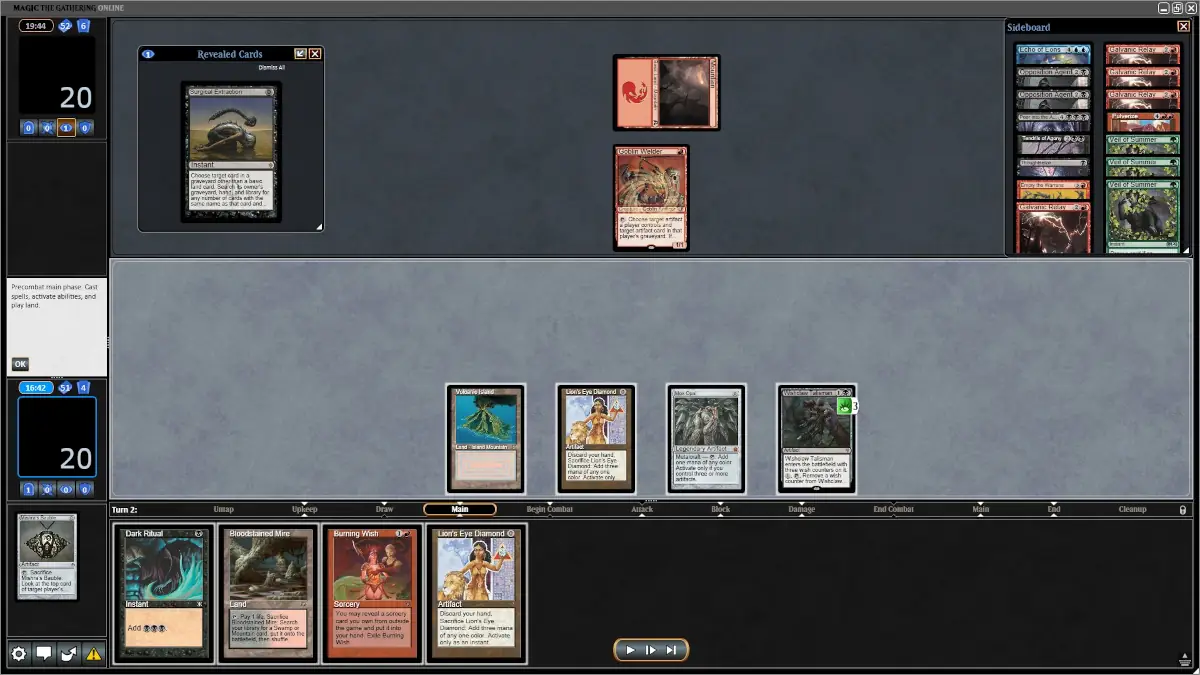
Want to see your play?
We're now allowing for fan-based submissions for "Infernal Tutoring!" In order to submit, scroll down to the footer to the contact form. Attach your screenshot, describe the situation in detail, and press submit!
Disclaimer: Regarding the details of the scenarios, we do not want what the outcome of the situation is. For example, if the question is, "Do I go for it here?" do not tell the team if your opponent had [[Force of Will]] or not. This information honestly doesn't matter for our purposes and it doesn't change the answer if it's correct or not to cast the business spell. Thank you for your understanding.
Instructions
- Use the subject line of "Infernal Tutoring"
- Write what list you are playing and if there's anything special about your list compared to the current stock version. Scenarios that contain the current list are more likely to be selected.
- If possible, please resize your images to be no larger than 1400px wide and preferably under 125kb. This will make our job easier, if you're unfamiliar how to do this that's okay too. Still message us with your scenarios!
